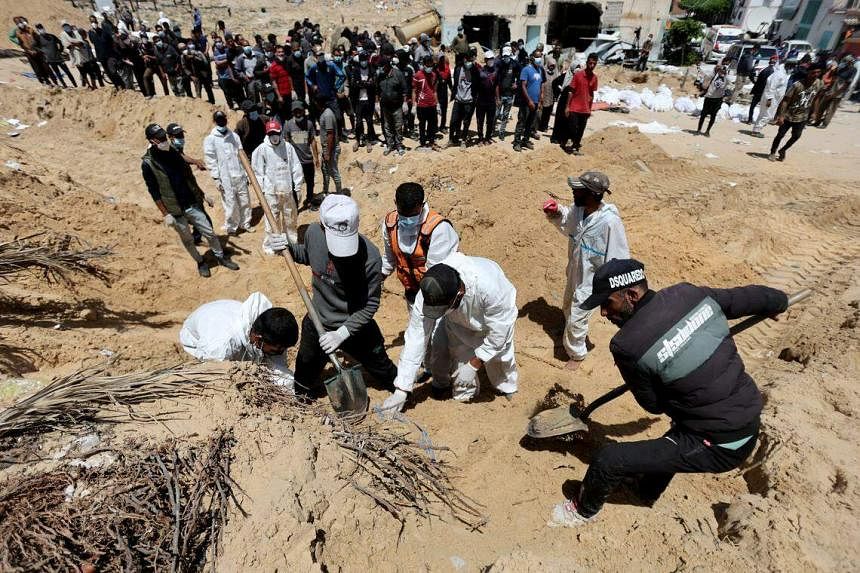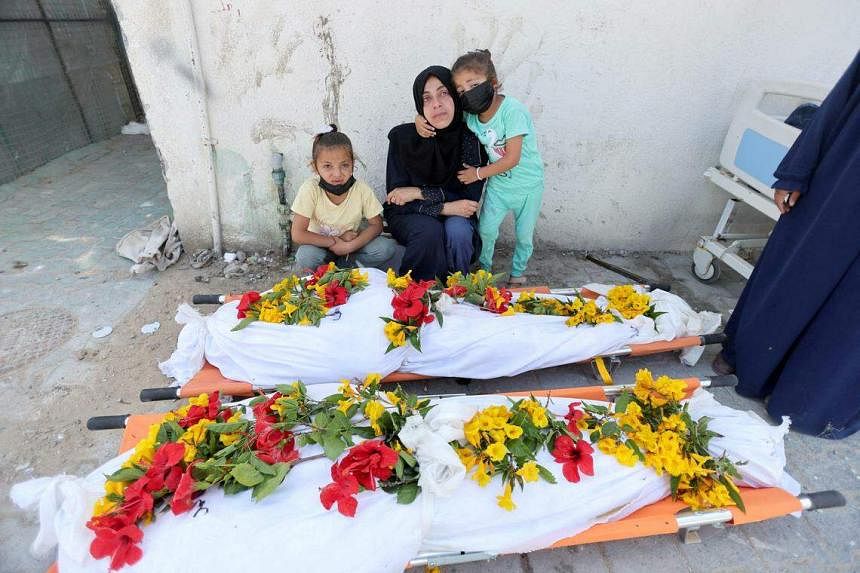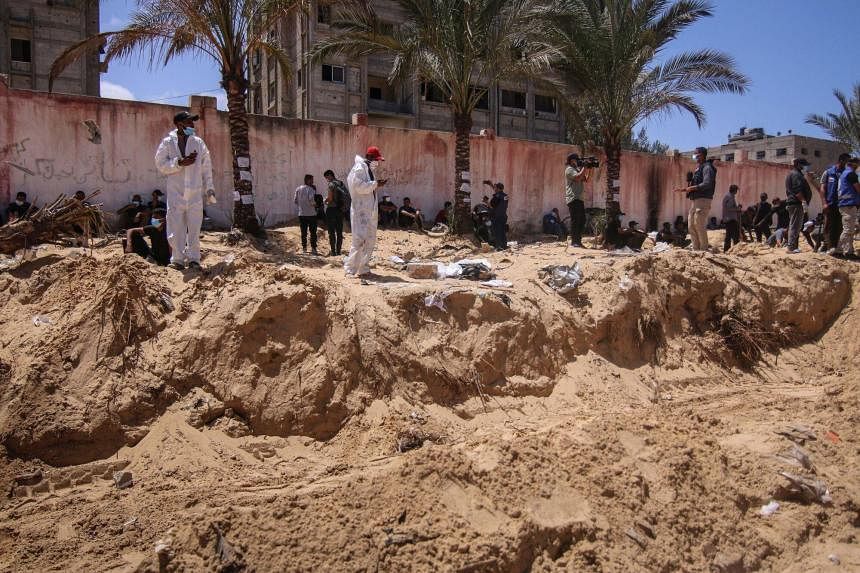GAZA STRIP - Palestinian officials in the Gaza Strip on April 25 increased the tally of bodies discovered in a mass grave on the grounds of a hospital to 392 from 283, amid conflicting accounts between Israel and the Gaza authorities over how and when some of the bodies were buried.
“This is the biggest mass grave since the beginning of the war,” Mr Mahmoud Basal, spokesman for Gaza’s Civil Defence, a search and rescue department within the Hamas-controlled territory, said on April 25 before calling for an international investigation.
A New York Times analysis of social media videos and satellite imagery found that Palestinians had dug at least two of the three burial sites weeks before Israeli troops raided the complex.
The Gaza authorities say that mass graves had been dug on the hospital grounds before an Israeli raid there in February but accuse Israel of later opening the site to add bodies.
It was not clear how those who were buried at the Nasser medical complex in the southern Gaza city of Khan Younis had died or exactly when.
While the Times could not determine the cause of death for individual people, the initial burials took place in January and February amid a weeks-long Israeli offensive in the city.
Israel on April 25 denied accusations that it was responsible for digging the graves at the complex but previously said it had opened them in the search for the bodies of hostages abducted to Gaza.
“Misinformation is circulating regarding a mass grave that was discovered at Nasser hospital in Khan Younis,” said Major Nadav Shoshani, an Israeli military spokesman, in a statement. “The grave in question was dug – by Gazans – a few months ago. This fact is corroborated by social media documentation. Any attempt to blame Israel for burying civilians in mass graves is categorically false and a mere example of a disinformation campaign aimed at delegitimising Israel.”
In the chaos of the six-month war, it has become common for Palestinians to bury the dead on hospital grounds, backyards and elsewhere, often hurriedly and without ceremony. But the rising tally of bodies pointed both to the human toll of the war and how hospitals have become flashpoints.
The medical centres have often been the first places people displaced by Israel’s bombardment have taken refuge, and their grounds have hosted thousands in makeshift tents.
Israeli officials say that medical centres have been the focus of raids because Hamas fighters embed themselves within and under the facilities and that it is the only way to root out the armed group. Hamas and medical workers have denied this accusation. Aid groups, researchers and international bodies have increasingly been calling Israel’s dismantling of Gaza’s medical capacity “systematic”.

Videos shared on social media and verified by the Times show that two sites with multiple mass graves were dug at Nasser, and bodies were buried starting in January.
Satellite imagery shows that the large mass grave first dug by Palestinians underneath the palm trees in the southern part of the complex was disturbed by Israeli forces, including with a bulldozer, lending credence to the Israeli claim that they exhumed and reburied bodies.
There is no clear sign that Israeli troops dug new graves or added bodies to existing ones.
On April 21, videos were shared on social media that show a third gravesite on the other side of a brick pathway that runs next to the initial mass grave. This new gravesite was created either during or after the Israeli occupation of the hospital grounds, but it is unclear who dug it. Signs written in Arabic at several of the graves read “Unknown martyr”.
The discovery of the graves last weekend has led to international calls for an independent investigation.
Joining the European Union and the United Nations, US President Joe Biden’s National Security Adviser, Mr Jake Sullivan, urged the Israeli government to “thoroughly and transparently” investigate the “deeply disturbing” reports of mass graves.
“We have been in touch at multiple levels with the Israeli government,” he said at a briefing on April 24. “We want answers,” he added.
The discovery of the mass grave at Nasser hospital came two weeks after a similar mass grave was found at Shifa hospital in Gaza City.
In a statement this week, Ms Ravina Shamdasani, a spokeswoman for the UN High Commissioner for Human Rights, cited reports that some bodies had been found with their hands “tied and stripped of their clothes”.
Those reports, which came from the Gaza authorities, could not be independently verified, and the group did not provide evidence for its claim.
At least one of the bodies exhumed since April 21 was seen wearing blue medical scrubs in a video posted to social media by a photographer, Mr Haseeb Alwazeer. The person appeared to have their hands bound together. This body was lying next to others exhumed from the mass grave in the palm grove.
Doctors at the hospital and the Gaza Health Ministry had said that some people who tried to flee the Nasser compound during the Israeli raid were shot at by Israeli soldiers, with some being killed or wounded.

While that claim could not be independently verified, multiple videos verified by the Times show gunshot victims lying on the ground just outside the north gate; others show people using a rope to drag bottles of water from across the street into the hospital complex to avoid a road where victims had been shot.
At the time, the Israeli military said that it had “opened a secure route” to evacuate the civilians in the area but did not respond to questions about reports that it had shot at Palestinians trying to leave the hospital.
Amnesty International’s senior director of research and advocacy, Ms Erika Guevara Rosas, said human rights investigators and forensic experts needed immediate access to Gaza to ensure that evidence of the graves is preserved in order to ensure accountability for any violations of international law.
“Without proper investigations to determine how these deaths took place or what violations may have been committed, we may never find out the truth of the horrors behind these mass graves,” she said in a statement.
Israel’s military left Nasser hospital in late February and continued to operate in Khan Younis before withdrawing from southern Gaza earlier in April. The withdrawal allowed Palestinian emergency services – and family members – to begin searching for the missing.
Mr Jihad al-Bayouk, 26, said that he had buried his older brother on the grounds of Nasser on Jan 24 after he was killed in what Mr al-Bayouk said was an Israeli drone strike on their home in Khan Younis. “I made sure to remember the place so I could come back later and give him a proper burial in a real cemetery,” said Mr al-Bayouk, 26, by phone on April 24.
He said that when he came back after Israeli forces had withdrawn from the area, he could not find his brother’s body or the palm trees he used to mark where it was. So he began digging every day, along with a crowd of others looking for the bodies of their loved ones.
“The digging went on for days” before he found his brother’s body on April 22 in a different spot from where he had buried him, Mr al-Bayouk said. He said that two of the three layers of plastic he had wrapped him with were gone, and the third was torn off but held together with plastic clips. NYTIMES

